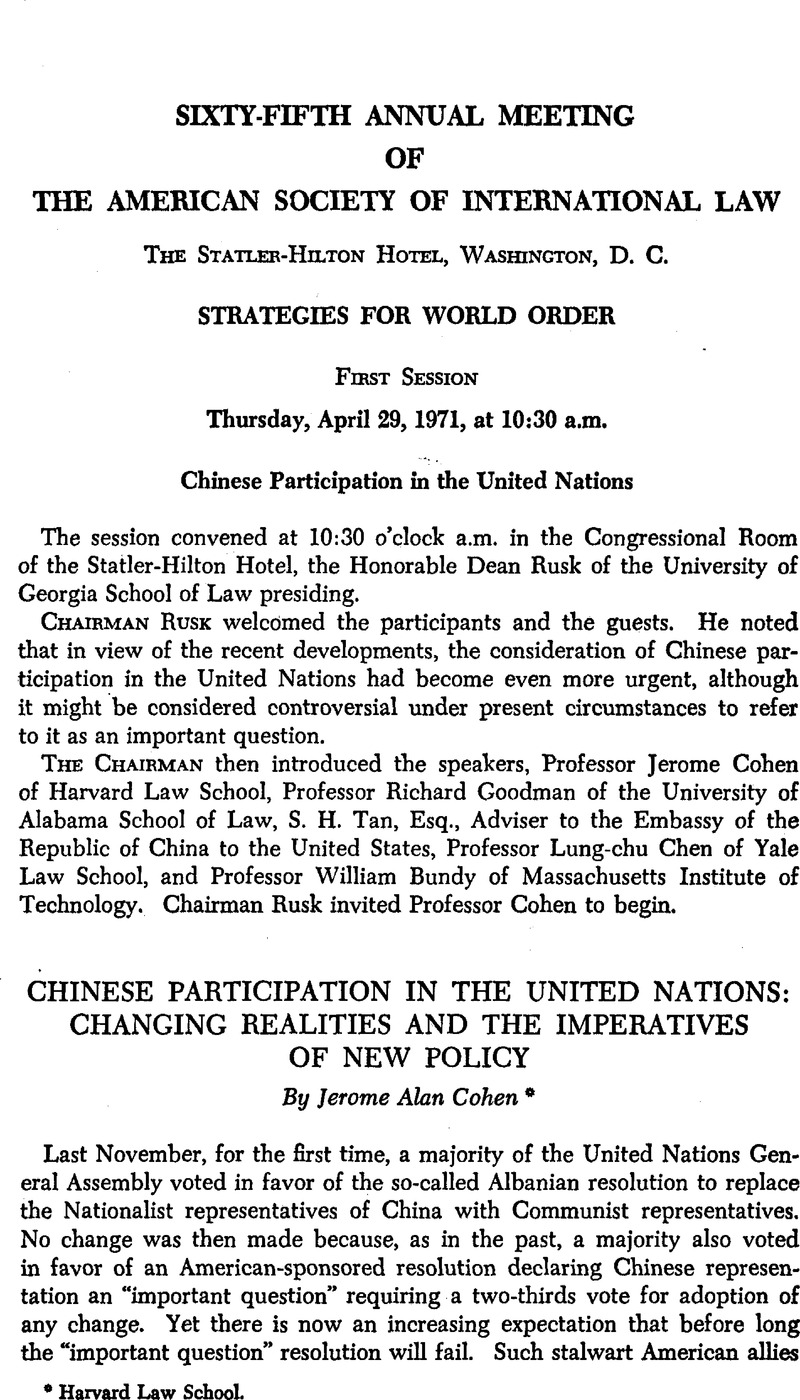No CrossRef data available.
Article contents
Chinese Participation in the United Nations: Changing Realities and the Imperatives of New Policy
Published online by Cambridge University Press: 28 March 2017
Abstract

- Type
- First Session
- Information
- Copyright
- Copyright © American Society of International Law 1971
References
1 McDougal, and Goodman, , “Chinese Participation in the United Nations: The Legal Imperatives of a Negotiated Solution,” 60 A.J.I.L. 671, 718 et seq. (1966)Google Scholar.
2 This agreement was formally manifested in Res. 396 ( V ) of the General Assembly, Dec. 14, 1950, the text of which may be found in Sohn, Cases on United Nations Law 117-118 (1967). For summaries of the history of the Chinese representation question and citations to the literature, see e.g., Ibid, at 104-124; and McDougal and Goodman, loc. cit. note 1, at 677 et seq.
3 See McDougal and Goodman, loc. cit. note 1, at 720-721. The authors seek to convey the impression that the Council “undercut the rationale of primary Assembly competence when that body [i.e., the Council] rejected an amendment to its Rules of Procedure which would have required the President of the Council to ascertain the views of all U.N. Members before the Council decided a ‘representation’ question.” Ibid. The authors neglect to point out that, in rejecting this proposal, the Council’s Committee of Experts suggested that “the question under consideration was of such a nature that the General Assembly should be the organ of the United Nations to initiate the study and to seek uniformity and co-ordination with regard to the procedure governing representation and credentials.” The quotation is reproduced in Sohn, op. cit. note 2, at 105.
4 See U.N. Doc. S/PV.1565, Feb. 9, 1971, pp. 23-41; and Washington Post, Feb. 10, 1971.
5 The quotation is from the preamble of Res. 396(V), loc. cit. note 2, at 117.
6 See McDougal and Goodman, loc. cit. note 1, at 696-702.
7 Art. 4(2) of the Charter provides that: “The admission of ta] state to membership in the United Nations will be effected by a decision of the General Assembly upon the recommendation of the Security Council.”
8 See McDougal and Goodman, loc. cit. note 1, at 673 (note 7).
9 Hsiung, , “China’s Recognition Practice and Its Implications in International Law,” in Cohen, (ed.), China’s Practice of International Law: Some Case Studies (Cambridge, Mass., Harvard University Press, 1972)Google Scholar.
10 See, for example, the recent remarks of the representative of Somalia: “It is ironic that one of the main supporters of the argument that China is not a peace-loving nation, the United States, has been involved in a war of aggression against the people of Viet-Nam where hundreds of thousands of people have been killed or maimed, and where atrocities comparable to those condemned at Nuremberg have been committed by its forces.
“... A number of those governments which arrogate for themselves the duty of passing moral judgments on the action of the Chinese Government in its international relations are themselves engaged in reprehensible conduct unbecoming to their membership of the United Nations.” U.N. Doc. S/PV.1565, pp. 29-30.
11 The quotation is from McDougal and Goodman, loc. cit. note 1, at 721.
12 The pertinent paragraphs of Art. 27 of the Charter state:
“2. Decisions of the Security Council on procedural matters shall be made by an affirmative vote of nine members.
“3. Decisions of the Security Council on all other matters shall be made by an affirmative vote of nine members including the concurring votes of the permanent members; provided that, in decisions under Chapter VI, and under paragraph 3 of Article 52, a party to a dispute shall abstain from voting.”
For discussion of abstention from voting by parties to a dispute and citations to the literature, see Sohn, op. cit. note 2, at 135-148.
13 It should be noted that the United States has not held a consistent position on the applicability of the veto to the representation question. In 1950, confident of its voting strength, it maintained that this was a procedural matter. In 1951 Secretary Acheson stated that, if the United States should find itself in a minority in voting on China’s representation, the International Court of Justice should be asked to determine the significance of a negative vote. In 1954 the United States announced that a negative vote on this question by a permanent member of the Council constituted a veto. Sohn, op. cit. note 2, at 106-107. For a discussion of the so-called “double veto” problem and citations to the literature, see ibid, at 148-231.




